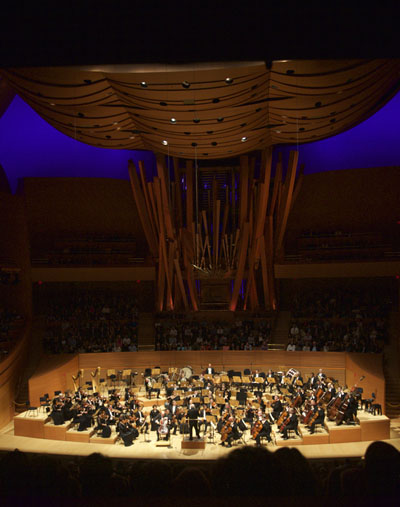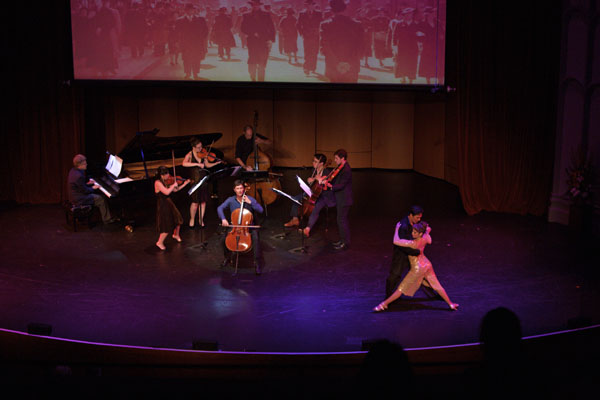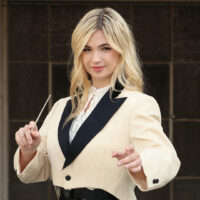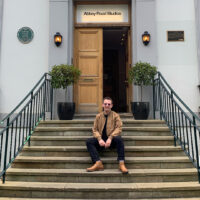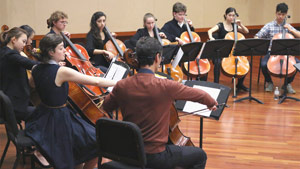
PICF ’16: A View of the Festival
By Christopher Hutton
Christopher Hutton, associate professor of violoncello at Furman University in Greenville, South Carolina and member of the Poinsett Piano Trio, provides a first-person narrative of his experiences at the Piatigorsky International Cello Festival.
CLOSING RECAP: MAY 22
Sunday was the closing day of the festival—bittersweet, of course, because although the past week has been filled with wonderful musical experiences, I have to admit I am reaching the limit of what I can absorb. It will be good to take with me such wonderful memories of my experiences here in Los Angeles.

A dozen pre-college age cellists gathered for a workshop and performance, under the guidance of Festival artist Antonio Lysy. (Photo by Daniel Anderson/USC)
The last day included some special events that were different from the usual classes and performances. In the morning, Antonio Lysy led the Young Cellists Workshop in the Alice and Eleonore Schoenfeld Symphonic Hall, a rehearsal and performance of music arranged for cello ensemble and played by about a dozen students who have been attending events but not (yet!) performing in the Festival master classes. There was a particularly nice arrangement of Debussy’s Claire de Lune by Niall Ferguson. In the late morning, several instrument makers and dealers participated in a forum led by Ralph Kirshbaum and Antonio Lysy on the challenges of purchasing fine instruments. And before the evening’s marathon Beethoven concert, Jeffrey Solow gave a talk he titled Don’t be an Urtext Victim.
Between these was an outstanding recital by Narek Hakhanzaryan and Noreen Polera playing Schumann, Brahms, Ligeti, Khachaturian, and the Paganini Variations on One String. It is hard to remember back to the opening gala of the Festival, but the Paganini was among the pieces that the duo Cello Duello played at Bovard Auditorium. Mr. Hakhanzaryan plays with such apparent ease, with a tasteful balance of expression and clarity, but great virtuosity as displayed particularly in the Ligeti and Paganini.
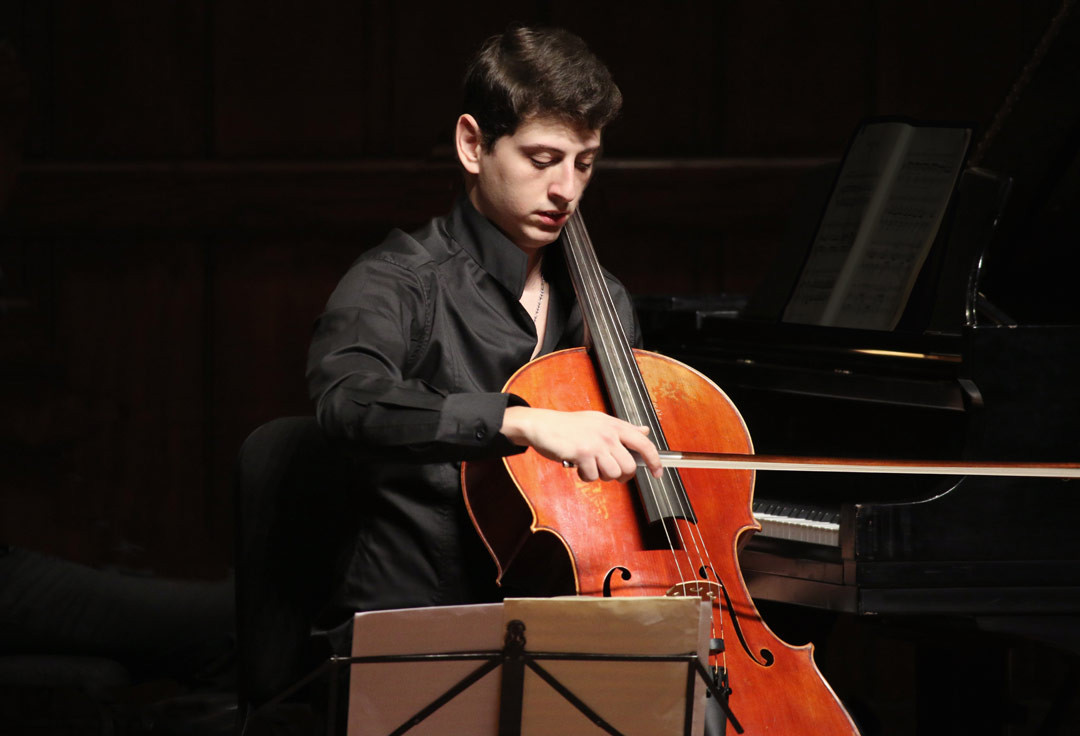
Armenian cellist Narek Hakhnazaryan performed in a lunch concert with pianist Noreen Polera at USC’s Alfred Newman Recital Hall. (Photo by Daniel Anderson/USC)
At 3:00 pm, Frans Helmerson led the final master class of the Festival, an extended session because it featured four festival Fellows rather than three as in the previous classes. Perhaps because it was the last day of the festival, the afternoon’s events seemed better attended than most of the week, with Alfred Newman Recital Hall almost at full capacity.
In the evening we were treated to the closing gala concert showcasing eight cellists (Ron Leonard, Laurence Lesser, Thomas Demenga, Colin Carr, Matt Haimovitz, Mischa Maisky, Andrew Shulman, and Jean-Guihen Queyras) joined by five pianists (USC Thornton faculty members Kevin Fitz-Gerald, Bernadene Blaha, and Jeffrey Kahane along with Christopher O’Riley and Lily Maisky) in performances of Beethoven’s five sonatas and three sets of variations for piano and cello. What a fantastic way to wrap up the festival! All of these great artists who now seem so familiar, after having seen them perform and teach all week, playing some of the greatest music for our instrument. And in many ways, this concert was a good summary of the festival as a whole: a chance to hear so many musicians back-to-back, showing a great diversity of approaches to similar repertoire, and also a chance to revel in Beethoven’s music from his earliest sonatas in Op. 5 to the later masterpieces of Op. 69 and Op. 102.
I realize that two festivals (in 2012 and 2016) does not necessarily make a tradition, but I will be looking forward to the possibility of a future Piatigorsky International Cello Festival. If it is possible I will make every effort to attend!
RECAP: MAY 21
We are now in the last couple of days of the festival, with only a handful of events left. Master classes remain at the center of the festival. Today, USC Thornton’s Ralph Kirshbaum led the morning master class and David Geringas the afternoon class. These were numbers ten and eleven out of twelve classes, meaning that I’ve now heard 33 of the 36 Fellows perform. The remaining three will play on the final class with Frans Helmerson on Sunday afternoon. In his class Mr. Kirshbaum mostly took a Socratic approach, asking a series of questions to hopefully lead each performer to different insights. Mr. Geringas, on the other hand, played much more than any other clinician this week: demonstrating both positive and counter examples in support of his points, accompanying and occasionally playing along with the Fellows.
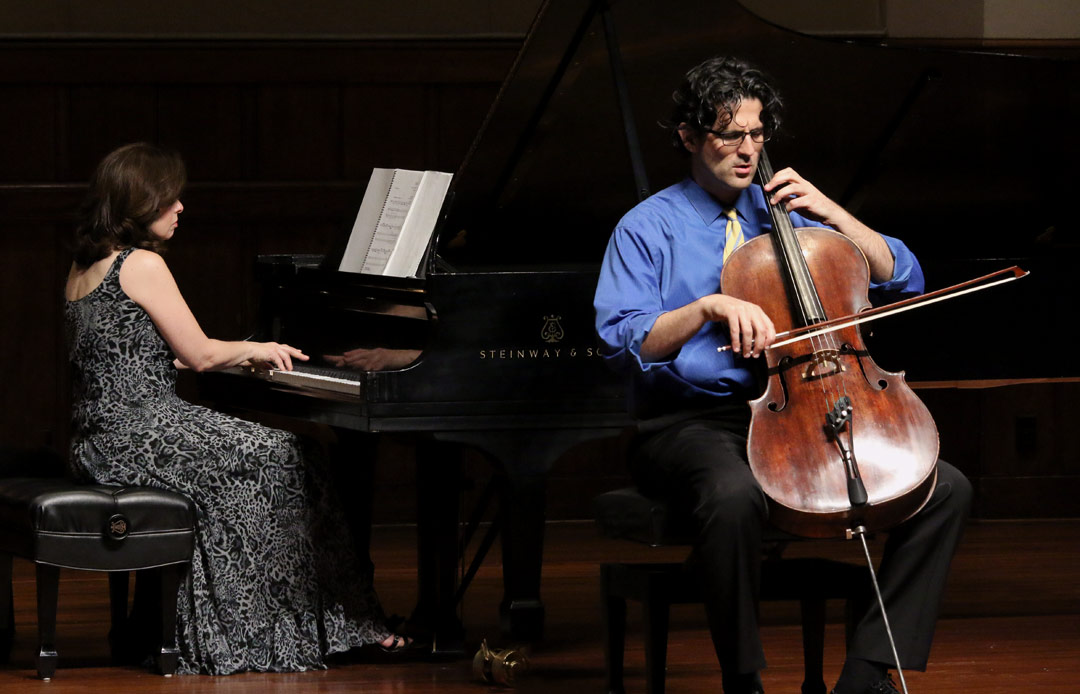
Amit Peled presented a Lunch Concert with pianist Noreen Polera on May 21st. (Photo by Scott Rieker/USC)
I very much enjoyed Amit Peled’s lunchtime recital with pianist Noreen Polera, which was the only program all week on which I didn’t know any of the repertoire. I think all three works were very effective, Mark Kopytman’s Kaddish (1981, revised for cello/piano in 1992), Sulkhan Tsintzadze’s Five Pieces on Folk Themes (a sort of Georgian mirror of Schumann’s Five pieces in a Folkstyle, written in 1950), and especially Lera Auerbach’s La Suite dels Occells (2015). Auerbach’s work, an homage to Pablo Casals, is a series of movements for solo cello inspired by Casals’ Song of the Birds and his performances of Bach Suites. As wonderful as it has been to hear so much of the established cello repertoire this week, it was exciting to hear something new that was so enticing that I wanted to immediately order a score. Although Auerbach’s publisher, Sikorski, mentions the piece on their webpage, it does not yet seem to be available for purchase. Hopefully it will be soon, as I am planning concerts next year in a project called Reflecting BACH that combine performances of Bach’s suites with later repertoire inspired or influenced by them (Reger, Britten, Bolcom, Harbison etc.). This piece would be a great addition!
Instead of an early evening concert, tonight there was a discussion with a panel of former students of Gregor Piatigorsky, the inspiration for and namesake of this incredible festival. Gail Eichenthal, executive producer of classical music radio station KUSC, led a conversation with Laurence Lesser, Mischa Maisky, Jeffrey Solow, and Raphael Wallfisch. Those of us who had attended master classes and concerts throughout the festival have heard a number of different anecdotes involving Mr. Piatigorsky over the week, but this was a chance to hear longer stories. Through their reminiscences each one of them shared his affection for his teacher, as well as a great admiration for his artistry and the way in which he challenged them as individual musicians.
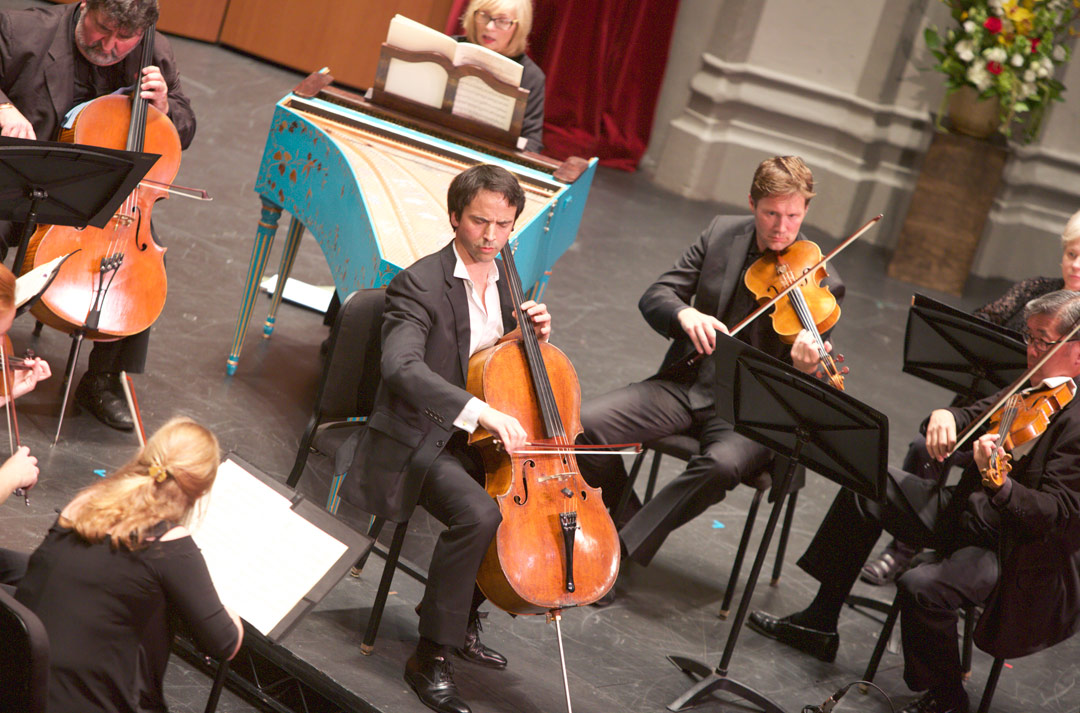
Cellist Jean-Guihen Queyras led the Los Angeles Chamber Orchestra in concerti by Platti and C.P.E. Bach on May 21st at USC’s Bovard Auditorium. (Photo by Dario Griffin/USC)
The evening concert presented a series of eighteenth-century concertos played by the Los Angeles Chamber Orchestra and Colin Carr (Antonio Vivaldi), Thomas Demenga (Luigi Boccherini), Jean-Guihen Queyras (Giovanni Benedetto Platti and Carl Philipp Emanuel Bach), and Giovanni Sollima (Leonardo Leo). Though the concert was as brilliant as one could hope for, I have to admit I was disappointed with the seats assigned to the purchasers of the week-long festival pass. Perhaps I have been spoiled by having such great seats for all the general-admission events all week?
One final day of the festival tomorrow and then it will be time to depart. Between guest artists and Fellows I expect that the Los Angeles International Airport will have a record number of cellists clearing security on Monday!
RECAP: MAY 20
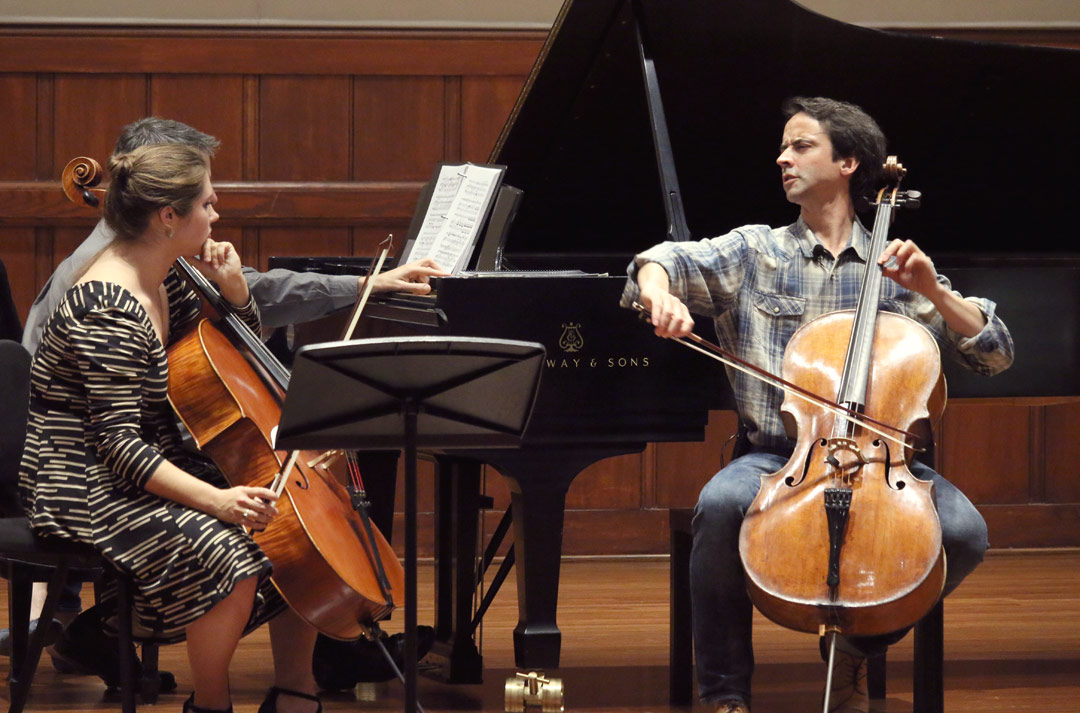
French-Canadian cellist Jean-Guihen Queyras led a Master Class on May 20th at USC’s Alfred Newman Recital Hall. (Photo by Daniel Anderson/USC)
In addition to the usual complement of masterclasses and concerts, today marked the opening of the displays of instruments (and accessories) in the Festival Exhibition Hall in USC’s Town and Gown. I was glad to see representatives from instrument dealers with whom I’ve worked before and others that I knew by reputation but hadn’t yet met. At a certain point I realized that representatives were present from the sources of my wife’s and my own instruments and bows: my cello came from J&A Beare, my bow from Carriage House Violins, back when they were affiliated with Reuning and Son; my wife’s violin was from Reuning and she bought her bow from Bruno Price of RVNY. It was a nice surprise to see Mark Braunstein and Bill Lee from William Harris Lee, who are supporters of the cello choir weekend, Cellobration, I’ll be hosting in South Carolina this September.
The day’s festival events were terrific, as usual. Colin Carr and Jean-Guihen Queyras gave fantastic master classes, during which they were both energetic and enthusiastic in the way they worked with the performers. I have fond memories of playing in the cello section of the New Zealand Symphony Orchestra when Mr. Carr was guest soloist for the Elgar and Schumann concertos. While on tour for a few days, I happened to be assigned the room next to his in our Auckland hotel, and I remember enjoying being the proverbial “fly” on (through?) the wall, hearing him practice.
Wendy Warner and pianist Rina Dokshitsky presented an enjoyable lunch-time recital of Brahms’ Sonata in E minor and Popper’s suite Im Walde. Like most cellists, I’m very familiar with the Gnomentanz movement, but I don’t think I had ever heard the rest of the suite, which I found to be very charming.
For me one of the highlights of the festival has been the variety of music exquisitely played by the SAKURA cello quintet, but none more so than their tremendously effective presentation of Anne Wilson’s Lament in memory of Matthew Shepard on tonight’s early-evening Quartet+ concert. This was followed by Jeffrey Solow and Ayke Agus playing three Piatigorsky transcriptions of Haydn, Schubert, and Weber, and finally two movements from Sergey Taneyev’s Quintet in G major, performed by Frans Helmerson and members of the Calder Quartet.
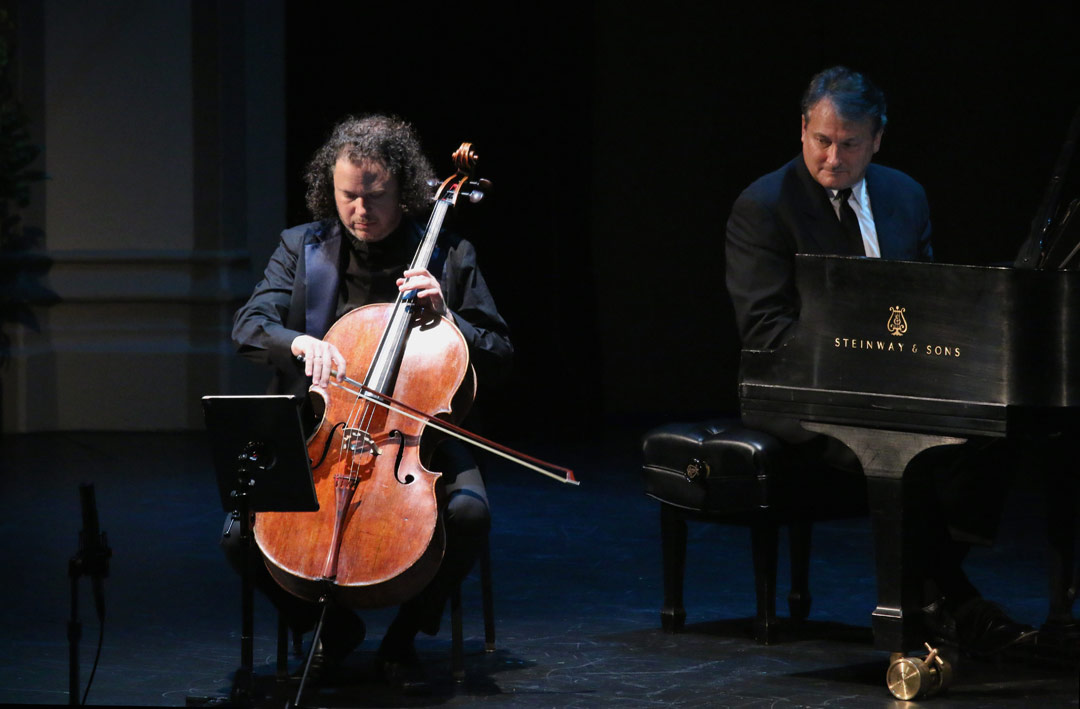
The May 20th Evening Recital at USC’s Bovard Auditorium featured cellist Matt Haimovitz with pianist Christopher O’Riley. (Photo by Daniel Anderson/USC)
As usual, the 6:30 concert ran a little long, but still ended in time for most of the audience to make their way across the courtyard to the evening concert. These cello/piano concerts have really been two short(ish) but self-contained recitals of a little over an hour each (Helmerson/Mørk; Gabetta/Geringas; and now Haimovitz/Maisky), divided by an intermission, and tonight was no exception. Matt Haimovitz and Christopher Riley performed some pop-song arrangements, a short piece by Philip Glass, and Prokofiev’s Sonata in C major. Mischa Maisky and his pianist daughter Lily Maisky played an innovative program of Anton Webern’s romantic, early (1899) Two pieces, followed immediately by the Three Little Pieces, Op. 11 which date from only fifteen years later, yet are dramatically different in their brevity and atonality. Because these short pieces still can be somewhat disorienting for audiences in their density of expression, it was wonderful to have them immediately repeated. When I last programmed these on tour myself, I played them immediately before and after intermission. Given a few minutes for the shock to wear off I usually found audiences to be much more receptive on the second hearing. The Maiskys played the fifth (cello) and eighth (violin) movements from Messiaen’s Quartet for the End of Time – the two prayers to the immortality and eternity of Jesus, both very slow in tempo and introspective in character before inexorably building to ecstatic climaxes. The final work on the program was Benjamin Britten’s Sonata in C major, the first of his five works written for Mstislav Rostropovich and among my favorite piano/cello sonatas. Beyond the programmed works the performers were generous with encores: Mr. Haimovitz and Mr. Riley played Rachmaninoff’s Vocalise, and the Maiskys rewarded the audience’s enthusiasm with a lyrical aria from Saint-Saëns’ Samson and Delilah and a satisfyingly raucous rendition of Bartók’s Romanian Folk Dances.
RECAP: MAY 19
Thursday was another full day of events. Larry Lesser led the morning master class with Fellows Annie Jacobs-Perkins, Tatsuki Sasanuma, and Charles Seo presenting 20th-century sonatas by Martinu, Prokofiev, and Barber. In the afternoon, Thomas Demenga worked with Coleman Itzkoff, Jeffrey Ho, and Jiaoyang Xu on Bach, Schubert, and Dvořák. These were both very effective classes, but seeing so many classes in quick succession one begins to notice various different approaches from clinicians in the way they budget their time. As pointed out by Mr. Maisky the day before, it is impossible to cover a whole movement in any depth in 40 minutes. Some teachers, like Mr. Lesser, tend to spend smaller amounts of time on more sections. Others, like Mr. Demenga, tend to spend more time on fewer sections. Both these approaches are effective in different ways, either allowing discussion of more different ideas or a depth of attention to detail. I have to say that I particularly enjoyed Mr. Itzkoff’s Bach and the way in which he worked with Mr. Demenga. Given that I’m planning performances of all six suites this coming season, that session was particularly inspiring.
The lunchtime recital today was Zuill Bailey’s tribute to Piatigorsky, assisted by USC Thornton faculty member Bernadene Blaha at the piano. Over twenty-five years ago (my how time flies!), Mr. Bailey and I played in youth orchestra together, and his sister is the orchestra director at the high school I attended in northern Virginia. File that one under “small world”! Or is that #SmallWorld? The program included a variety of pieces connected to Piatigorsky in different ways: Lukas Foss dedicated his “Capriccio” to him, Piatigorsky collaborated to some degree with Stravinsky in creating his “Suite Italienne,” the cellists arranged the Chopin Nocturne in C-sharp minor, “re-“composed the Boccherini sonata (from a variety of sources), and completely composed his own variations on a Paganini Theme (with caricatures of his friends and colleagues). To me, the gem of the program was the Chopin, but I think the audience’s favorite was the flashy set of variations.
There was not an early evening recital today, but during that window of time Giovanni Sollima led what was billed as an improvisation workshop. But really, the term “workshop” does not do justice to what was basically a 90-minute jam session with the Fellows that culminated in the creation of a 15-minute, four-movement symphony (with the finale based on Nirvana’s “Smells like teen spirit”), followed by an extended encore that eventually included Mr. Sollima leading the ensemble outside (while still playing). The level of spontaneity that he had shown on stage earlier in the week (first in his “Improvisation” on Sunday, and then later in the Boccherini Quintet) was on full display. A recent review by Mark Swed called him the “Roberto Benigni of the cello,” but today he was a cellistic Pied Piper as he cajoled the young musicians through the improvisation with relatively little verbal communication necessary.
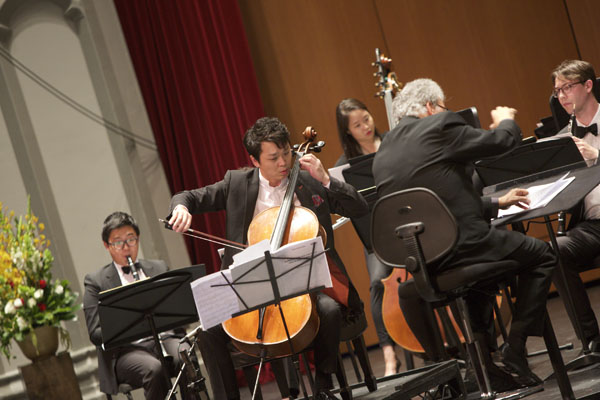
On May 19, cellist Li-Wei Qin performed with the USC Wind Ensemble. (Photo by Dario Griffin/USC)
The evening concert was a special treat in that it offered three works that are relatively rarely played. Conductor Uriel Segal directed musicians from the USC Thornton Wind Ensemble and Chamber Singers in support of Raphael Wallfisch playing Ibert, Li-Wei Qin playing Gulda, and finally David Geringas in Sofia Gubaidulina’s The Canticle of the Sun. I’d heard the first two works on several occasions, and have been trying to program the Gulda for a couple of years myself, but the Gubaidulina was a special treat. Probably because of its length (45 minutes or so), difficulty, and instrumentation (solo cello, percussion, celeste, and chamber choir) it is rarely performed, though there are at least three professional recordings available. I had never heard the piece live, and I have to say I think that I enjoyed it much better than my first impressions from recordings. There is a theatricality inherent in the performance itself not to mention the spatial effects created by the way in which different solo voices in the choir appear and disappear.
The weekend will bring several important events—master classes with Colin Carr, Jean-Guihen Queyras, Ralph Kirshbaum, David Geringas, and Frans Helmerson; recitals by Wendy Warner, Amit Peled, Matt Haimovitz, Mischa Maisky, and Tchaikovsky Competition winner Narek Hakhnazaryan; and concerts that include the Saturday evening “Baroque Conversations” program with FIVE concertos, and Sunday evening’s final program of Beethoven’s complete works for Piano and Cello. In other words, under most circumstances the events of the next three days would be a tremendously important festival in their own right. But here at the Piatigorsky Festival they only represent one third of the events taking place this week.
RECAP: MAY 18
Presumably because of a need to allow time for rehearsals in advance of Tuesday evening’s concert, the schedule over the early days of the festival had a little bit of breathing room between public events. No longer! From Wednesday through the closing Gala concert this Sunday evening the Piatigorsky Festival kicks into high gear with events from morning till evening.
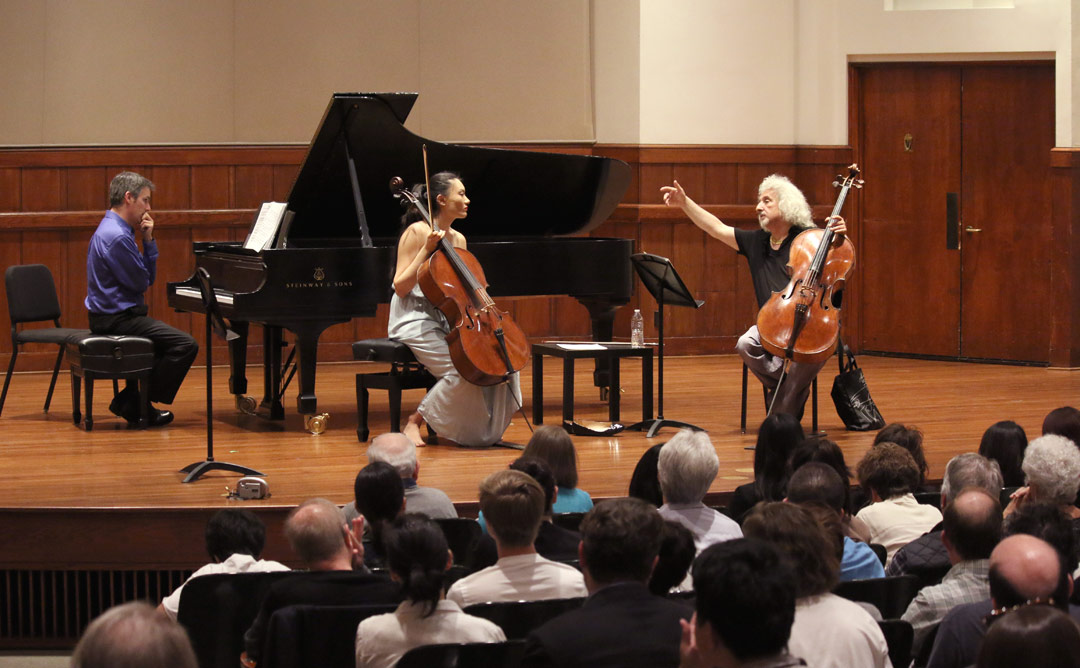
On May 18, Latvian-born Israeli cellist Mischa Maisky led a master class at USC’s Alfred Newman Recital Hall. (Photo by Daniel Anderson/USC))
Wednesday’s schedule was typical: 10-12 pm: master class with Ronald Leonard; 1-2 pm: recital by Wolfgang Emanuel Schmidt; 3-5 pm: master class with Mischa Maisky; 6:30-7:30 pm: early evening recital by SAKURA, Laurence Lesser, and Antonio Lysy joining the Calder Quartet, and then an evening recital at 8 pm with Sol Gabetta and David Geringas. That is eight hours of (glorious) cello playing and classes. In my “normal” life teaching and playing it wouldn’t be unusual to have that much music in a day between lessons, chamber coachings, and my own practice, rehearsals and performances. The difference here is that I am not personally responsible for a single note, which is a luxury in many ways. I have to admit though, by Wednesday of the festival my fingers are itching to get an instrument into my hands. If I’m lucky enough to attend this festival again in the future I think I’ll need to reconsider leaving my cello at home.
With so many events it becomes difficult to describe everything, but I should say a word about the two classes, and a couple of highlights from the performances. I was looking forward to Ron Leonard’s class at least partly because I had played for him on a few occasions as a graduate student. Mr. Leonard was, in my experience, always very direct and to the point in the way he called attention to my weaknesses, which is why I sought him out. In that respect he reminded me very much of my undergraduate professor, Leslie Parnas. During Wednesday’s class he raised several themes that I remember being important in my own sessions with him: beware of too many inflections within the line, take care of the bow angle and contact point, make sure that rubato doesn’t unnecessarily distort the underlying rhythm, and so forth. All things that I still think about now when critiquing my playing in the practice room.
The afternoon class with Mr. Maisky was unlike any I have ever attended. Three Fellows performed (Dvořák concerto and Bach’s sixth suite). But rather than working directly with the students, following each performance Mr. Maisky launched into extended comments upon a wide variety of topics. I don’t remember the students playing a single note beyond their initial performances. That said, I took three pages of notes upon such different subjects as “authenticity” in performance (in Mr. Maisky’s opinion the most important kind of authenticity is “from the heart”), to Bach’s place in the world (he was “so progressive, he was ahead of his time, and it took 100 years for the world to catch up”); that we can all learn from listening to live and recorded performances with an open mind, and to not be afraid of difference. So many core ideas that could be gathered together to form a sort of artistic credo.

The May 18 Evening Recital at USC’s Bovard Auditorium featured cellist David Geringas and pianist Rina Dokshitsky performing Schnittke’s Cello Sonata No. 1. (Photo by Daniel Anderson/USC)
In terms of concerts, Wednesday brought very many great performances. Wolfgang Emanuel Schmidt’s lunchtime recital of Schumann, Shostakovich and Debussy was beautifully crafted. SAKURA’s presentation of madrigals was simply extraordinary, and that was followed by Laurence Lesser’s performance of the Lute version of Bach’s C minor Suite. Personally, I find the cello version to be challenging enough, but it is definitely interesting to hear the extra chords and ornaments which are somehow more pronounced on the cello than when listening to a performance on lute. I was completely blown away by the performance of Onslow’s Quintet No. 15 in C minor by the Calder Quartet and Antonio Lysy. I think I’ve heard this piece before at some point, though it is possible that I’m remembering a different quintet by the same composer. In any case, my memory of that previous performance didn’t prepare me for the impressive energy and unanimity of ensemble tonight.
Likewise, Sol Gabetta and Kevin Fitz-Gerald’s performance of Chopin’s Sonata and Grand Duo Concertante was amazing, with virtuosity combining with great expression. They were followed by David Geringas and Rina Dokshitsky playing the Schnittke Sonata No.1, which sounded particularly dark after the brilliance of the Chopin. I was delighted to hear the “Pianissimo” movement from Vask’s “Das Buch”—which happened to be the same piece that Ms. Gabetta had played as an encore on Saturday afternoon. It was wonderful to be able to identify the work, as well as to hear the piece again so soon.
RECAP: MAY 17
There were no cello recitals at the USC campus on Tuesday. Instead there were two impressive master classes, with Jens Peter Maintz in the morning and Truls Mørk in the afternoon. As with Monday’s class, the performances of the Fellows were fantastic, which meant that the classes were able to operate at a very high level.
The morning class focused on eighteenth-century music of three very different types: Haran Meltzer played the first movement of Haydn’s D-major Concerto, Brannon Cho played Beethoven’s Variations on “Bei Männern” from Magic Flute, and Gabriel Martins performed the Prelude of Bach’s C major Suite. Vivian Fan was an able collaborator at the piano for the Haydn and Beethoven.
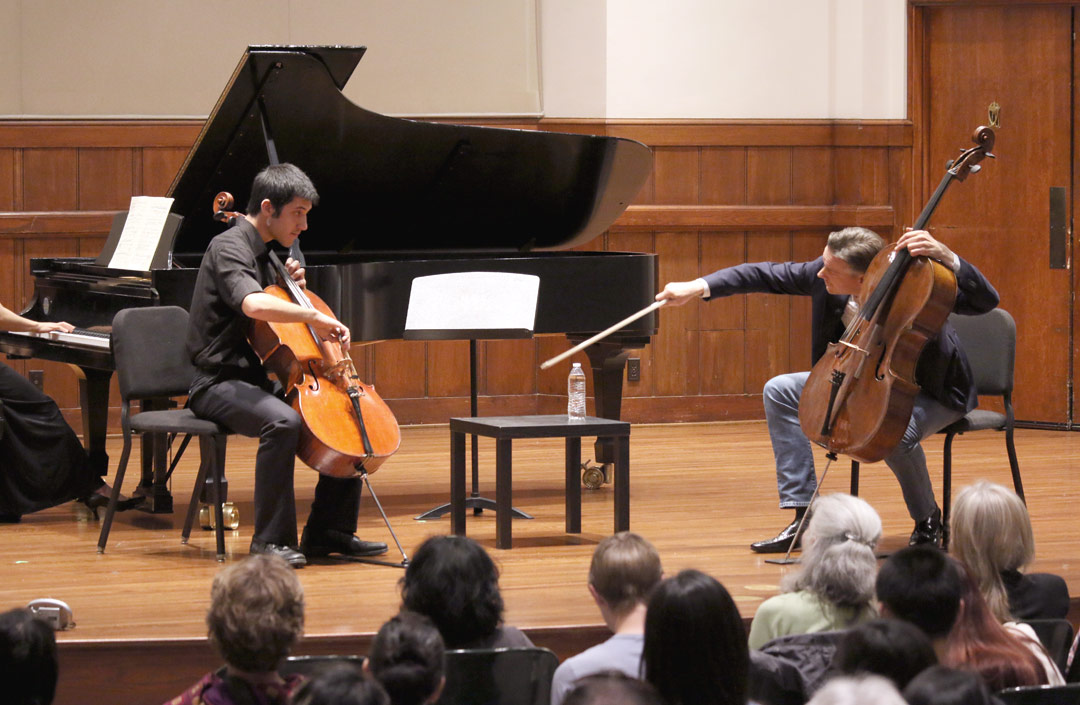
On May 17, German cellist Jens Peter Mainz led a master class with student Fellow Haran Meltzer at USC’s Alfred Newman Recital Hall. (Photo by Daniel Anderson/USC)
Though the details under consideration certainly varied, Mr. Maintz continually asked the performers to strike a pragmatic balance between seeking variety of expression, of articulation, and of color, yet with an eye towards what can be learned from the original source materials, and how that might influence their decisions. Not in a limiting way, but rather as a way to open up more creative possibilities. Seemingly small details often make a significant difference in affect, a point that was demonstrated many times over. I will definitely consider his ideas about appoggiatura lengths in mid- versus late-eighteenth century repertoire. I have a recital project planned for next year that will include performances of the complete Bach Suites, and so it was particularly interesting to hear Mr. Maintz talk about extrapolating from comparisons between the autograph and Anna-Magdalena Bach’s copies of the violin sonatas and partitas, and how that might help us to interpret her copies of the cello suites. Though I’ve certainly spent time with various scholarly editions and facsimile manuscripts of the 18th-century sources, that is an approach I have never considered.
In the afternoon, Zlatomir Fung gave an astonishingly strong performance of the first several movements of Britten’s first Suite, followed by Sebastian Bertoncelj playing Grieg’s Sonata in A minor and Chris Mui ending with the first two movements of the Elgar concerto. Robert Thies played the piano parts for the Grieg and Elgar. The Grieg and Elgar are of course works that Mr. Mørk has performed at the festival in just the past few days, so I’m sure that many assembled still had those performances resonating in our ears. Each of these pieces was quite different, but there were common themes: think carefully about using rubato as in many cases it can be better to be more rhythmical, yet at times we must allow for bending of time. Be careful about the pace of building and especially releasing intensity. Consider the triple balance of weight, speed, and contact point, with a particular attention to the latter because that is the one of the three that we often don’t sufficiently contemplate. Find fluidity in the bow arm. All things that cellists probably know, but worth reconsidering as we so often get caught up in the logistics of playing complex passages and producing sound.
At the end of the class, Mr. Mørk generously offered to answer questions and made some thought-provoking points about practice, about the many opportunities that are open to cellists today, and what he saw as the great improvement in cello playing over the past 40 years. I am sure that the session would have gone on for as long as he could stay, but unfortunately the hall was soon needed for a rehearsal for one of the many upcoming events.
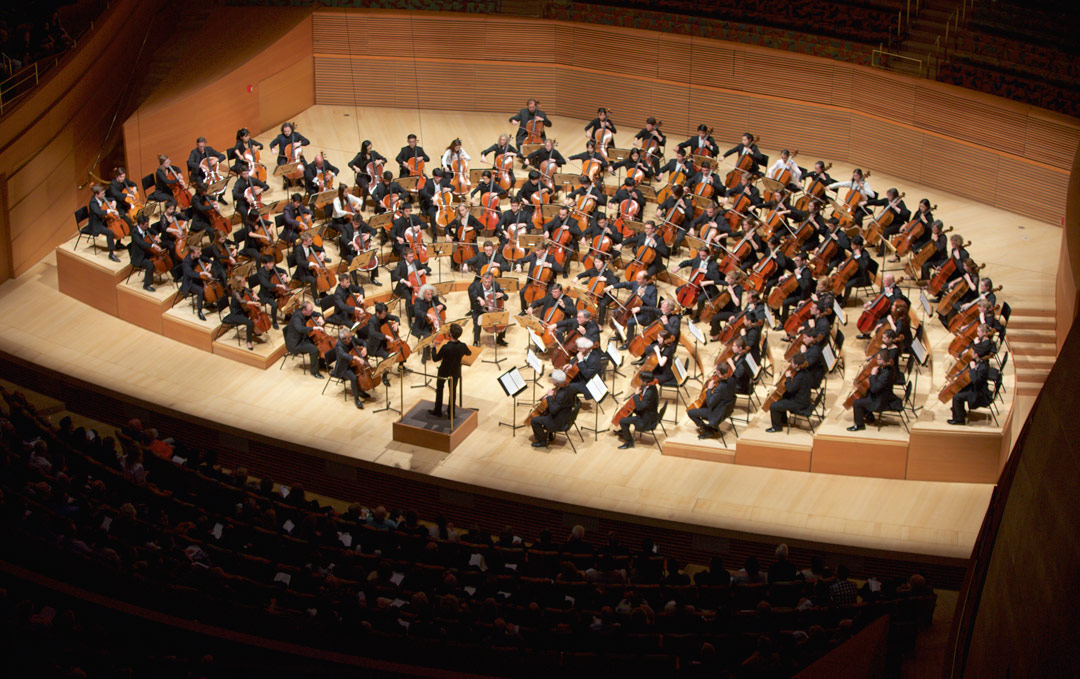
On May 17, 2016, over 100 cellists took to the stage of Walt Disney Concert Hall for the premiere of Anna Clyne’s “Threads and Traces,” as well as movements from Villa-Lobos’s beloved “Bachianas Brasileiras,” under conductor Matthew Aucoin. (Photo by Dario Griffin/USC)
The evening concert was the last festival event to take place at Walt Disney Concert Hall. The first half of the program was a first-rate rendition of Schubert’s masterwork, Quintet in C major, with festival host Ralph Kirshbaum joining the Emerson String Quartet. The second half was of music entirely for cellos: Brett Dean’s Twelve Angry Men in a taut performance by members of the SAKURA quintet and several guests, and then works for mass cello choir led by conductor Matthew Aucoin—the world premiere of Anna Clyne’s Threads and Traces and a large-scale version of Hector Villa-Lobos’s octet, the Bachianas Brasilieras No. 1.
I know something about large cello choirs as I have hosted the South Carolina Cello Choir weekend a few times and will again this coming fall. Our “Cellobration” is an annual event that draws cellists from the southeast for a weekend of master classes and events. I last hosted in 2014, and we had about 180 players on stage from near beginners to college students to professionals. Although we had more cellos, we certainly didn’t have the illustrious performers gathered at Disney Hall—the inner circles of international soloists surrounded by the festival Fellows and accomplished younger players. Many of the young musicians are here for the Young Cellists Workshop, and I sat adjacent to the family of a high school student who had traveled to Los Angeles for the event and was onstage. Like everyone in the audience, they were reveling in the marvelous spectacle and the wonderful sound that only a cello choir can make!
RECAP: MAY 16
Robert deMaine has been a busy man these last few days. After leading the cello section of the Los Angeles Philharmonic for three weekend concerts featuring his beautiful solos in the William Tell Overture and accompanying guest concerto soloists Ralph Kirshbaum, Truls Mørk and Sol Gabetta, deMaine played the first of the Festival’s lunchtime recitals on Monday. He presented Hindemith’s solo sonata, Op. 25 No. 3, Cassadó’s Suite for Solo Cello, and several of his own Études-Caprices—in other words, a program of unaccompanied works. The Hindemith and Cassadó are pieces I play and teach, so I enjoyed the particularly fine performances of both works. I was especially enamored with the middle movement of the Hindemith, which Mr. deMaine took at a much slower tempo than I play, which was very successful. I’m going to have to reconsider my own approach. Alas, his Études are unpublished. I feel certain that if copies had been available for sale after the concert many of the cellists in the audience would have immediately snapped them up, especially the one based on the National Anthem which ended his program and would make a terrific encore!
After a short break, Raphael Wallfisch began the first master class of the festival, working with three of the Festival Fellows who travelled to Los Angeles from across the country and indeed around the world. Cicely Parnas, who already has the beginnings of a successful solo career, happens to be the granddaughter of the great cellist Leslie Parnas, with whom I studied at Boston University as an undergraduate. I heard her last summer when she played a concerto with the Brevard Festival orchestra, and was duly impressed then, so it was good to hear her again. All three young artists gave accomplished performances of sonatas, collaborating with pianist Robert Thies. Ms. Parnas played the first movement of Brahms’ Sonata in E minor, followed by Yoon-Kyung Cho playing the first movement of Beethoven’s Sonata in C major, and Evan Kahn played Debussy’s Sonata in D minor. The level of artistry and technical facility from each player was extremely high, and all three were incredibly responsive to the expressive suggestions of Mr. Wallfisch.
The evening included two concerts, one at 6:30 pm and another at 8:00 pm. The earlier concert commenced in Alfred Newman Recital Hall with the five cellists of the SAKURA quintet playing Werner Thomas-Mifune’s brilliant and humorous fantasy on themes from Bizet’s Carmen. The quintet was followed by Ronald Leonard, the longtime principal cellist of the LA Philharmonic and former holder of the Piatigorsky Chair at the USC Thornton School of Music. When I was a student, I had occasion to play for him a few times in master classes both at Eastman and when I was in the New World Symphony, and for a lesson at his home in Los Angeles, so it was great to hear him perform. Mr. Leonard was joined by Bernadene Blaha, a piano colleague from USC Thornton. Mr. Leonard and Ms. Blaha played two movements from Boccherini’s Sonata in A major, and Samuel Barber’s richly romantic Sonata, Op. 6. After that warmly-received performance, the Calder Quartet took to the stage with Giovanni Sollima, who so easily communicates the sheer joy of playing the cello. He plays with such gusto that it is hard to imagine anybody not being closely engaged in his performance.
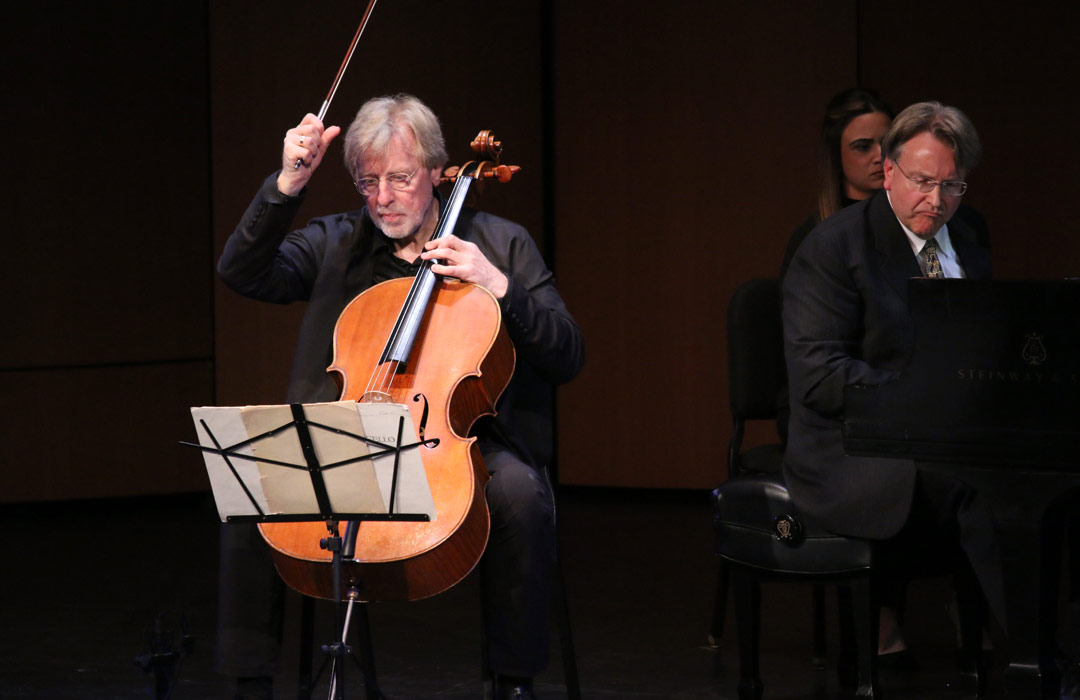
Cellist Frans Helmerson performs with Kevin Fitz-Gerald at USC’s Bovard Auditorium (Photo by Daniel Anderson/USC)
Most of the audience then walked across the courtyard for the final concert of the day in nearby Bovard Auditorium. This program featured Frans Helmerson in the first half, with USC Thornton faculty member Kevin Fitz-Gerald at the piano and then Truls Mørk and Bernadene Blaha in the second half. Mr. Helmerson played Debussy’s effervescent Sonata heard earlier in the day on a master class, and then the monumental G minor Sonata by Sergei Rachmaninoff. The latter piece, which I love dearly, often sounds to me a bit like a piano concerto with a single cello taking on the role of the orchestra. But it must be said that tonight the balance was phenomenally good, testament to the extraordinary skill of Mr. Fitz-Gerald as he made short work of one of the most challenging works in the sonata literature and made sure that Mr. Helmerson’s lyrical melodies were never overwhelmed. Mr. Mørk and Ms. Blaha played all Scandinavian music, short pieces by Grieg and Sibelius followed by another large, Romantic sonata: Grieg’s Sonata in A minor. As in the Rachmaninoff the balances were wonderful, and the pair of performers allowed for the almost constant push and pull of rubato that this piece requires. Mr. Mørk’s tone was luminescent, even when at full voice. His bow control is simply exquisite.
One aspect of the festival that I hadn’t anticipated is that I might see old friends. Two former colleagues from the Eastern Music Festival were here today, and I was also glad to finally have the opportunity to meet Prof. David Starkweather who teaches at the University of Georgia, only 100 miles from Furman University, where I teach. I suppose that the cello world is small enough that when you get enough of us together there are going to be lots of overlaps. There are certainly lots of cellists here this week!
RECAP: MAY 15
I have been looking forward to attending the Piatigorsky Festival for several months, and it is wonderful to finally be here in person. I feel very lucky that my home teaching institution, Furman University, has generously funded my attendance.
Sadly, I missed Friday night’s concert with Ralph Kirshbaum playing Schelomo, but I was unable to get to Los Angeles until Saturday afternoon. My first event was therefore the Saturday evening concert of the LA Philharmonic with Leonard Slatkin conducting and Truls Mørk as featured soloist in Elgar’s concerto.
I had never been to Disney Hall before, so I didn’t know quite what to expect. My ticket for the concert placed me in the highest-level balcony, five floors up from the orchestra level. But even so, the sound was terrific and there were wonderful sight-lines. I don’t think there is a bad seat in the house.
The program opened with Rossini’s Overture to William Tell, no doubt selected because the opening section features a very significant cello solo with principal cellist Robert deMaine taking the lead. The main (to my mind) attraction of the concert was Truls Mørk playing the Elgar Cello Concerto. Even before coming to the festival I fully expected this to be a highlight, and indeed Mr. Mørk gave a masterful performance. He played by turns with extraordinary subtlety and nuance where needed, and yet great excitement in the more extroverted sections. The second half was Berlioz’s Symphonie Fantastique. The orchestra sounded very, very good, with wonderful principal soloists and great energy throughout the string sections.
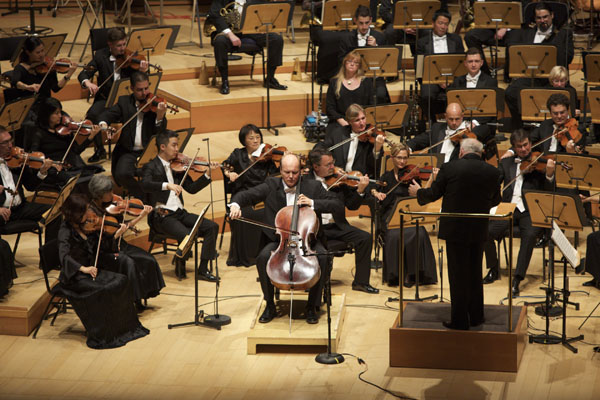
Cellist TrulsMørk performs with the LA Phil (Photo: Dario Griffin/Piatigorsky International Cello Festival)
Sunday was a big day, with three concerts. The afternoon brought me back to Disney Hall where I took up my spot in the top balcony. After a reprise of the Rossini overture, Sol Gabetta gave a stunning performance of Martinů’s Concerto No. 1, which I only know from (another festival artist) Raphael Wallfisch’s recording on Chandos, which I adore. I know some of the people seated around me were a little nervous about the prospect of a “modern” piece (over 60 years old!), but they were pleasantly surprised by the jazzy idiom of the outer movements and the beautiful lyricism of the middle movement. From my seat in the top balcony I couldn’t hear the announcement of the encore, but was greatly impressed by the extraordinary colors Ms. Gabetta coaxed from the instrument and her self-accompanied singing. Was this maybe something written for Maya Beiser? I’d love to hear it again, so will have to find out. Unfortunately I had to leave at the intermission, missing a second hearing of the Berlioz, in order to be sure that I was able to hear the Gala Opening at Bovard Auditorium down at USC.
That Opening Gala concert was absolutely spectacular! Jens Peter Maintz and Wolfgang Emanuel Schmidt performed as “Cello Duello” with incredibly virtuosic playing. They started with a Haydn “Duo,” which—according to the program—was a pastiche of movements from a couple of pieces that I’d never heard before, followed by “Caprice” by Servais and an arrangement of Paganini’s Moses variations. The technical prowess of both players was evident throughout, but one aspect that I found particularly impressive was how well the two players blended their tone, to the point that it could be difficult to tell which player was playing which notes. When passages were passed off between cellists it truly sounded like a single performer.
The balance of the first half was Giovanni Sollima’s performance of his own Improvisation, a set of variations that used virtually every part of the cello. He brought an enthusiasm and commitment to every note that was infectious, bringing the audience along with him to laugh at his musical jokes and cheer with gusto at his panache.
After the intermission, Antonio Lysy presented excerpts from an experience called Te Amo, Argentina, integrating well-known works by Piazzolla (“Verano” from The Seasons, Oblivion, and Le Grand Tango) with works by Alberto Ginastera, Osvaldo Golijov, and José Bragato – the latter a cellist/composer who I had not heard of before. Mr. Lysy was joined by the Attacca Quartet, bass player Benjamin Pendergrass, pianist Bryan Pezzone, and two dancers – Miriam Larici and Leonardo Barrionuevo, who brought the Tango to life on stage. The performance was accompanied by projected visuals and some brief introductions to pieces in the composers’ own words. The combination of elements made for an interesting performance, with the highlight to me being the extremely polished playing of all the performers in combination with the tightly choreographed dancing.
Under normal circumstances that would be enough music for one day, but instead I returned downtown for Yo-Yo Ma’s recital with Kathryn Stott at the piano. They began with a series of short pieces all played without pause, followed by a rousing performance of Shostakovich’s Sonata in D minor. The short works—which included such chestnuts as the Ave Marias of both Bach/Gounod and Schubert and less-well known pieces by Sibelius, Gade, and Debussy—were all from Mr. Ma’s new album, Arc of Life. It was a pleasant way to begin the recital, highlighting a wide tonal palette with many soft and deliberately understated colors. The performance of the Shostakovich that followed demonstrated an extraordinary range, from the subtleties and restraint in moments of the first and third movements, to the rip-roaring extroverted characters of the scherzo and finale, each of which were taken at break-neck tempos.
The second half featured a performance of Giovanni Sollima’s Il Bell’Antonio, which built from a quiet, minimalistic opening to an exciting climax, and was very well-received by the audience, and then Franck’s “violin” Sonata. The reaction to Mr. Ma and Ms. Stott’s performance of the Franck was so enthusiastic that the audience broke in between movements, their applause quickly subsiding as they realized that the performers had already begun the next movement. Mr. Ma was in fine form, and Ms. Stott gave a stirring performance bringing great expression to the fistfuls of notes written in the piano part. After the official program ended, the audience was finally able to applaud as they had desired to do all along, with their fervor rewarded by encores.
After such a remarkable opening weekend I am very excited about the rest of the festival. Just paging through the program book makes me eagerly anticipate the experiences of the coming days.
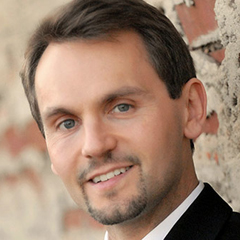
Christopher Hutton is an avid performer and is the cellist for the Greenville-based Poinsett Piano Trio. A native of New Zealand, Hutton has performed across the globe and worked with a number of orchestras, including the New World Symphony and the New Zealand Symphony Orchestra. He has recorded for New Zealand’s Concert FM and Germany’s SWF Radio as well as Albany Classics for a disc of contemporary chamber music for Albany Classics. Hutton plays on a cello made by John Betts in c. 1795.
A graduate of Boston University and the University of Rochester’s Eastman School of Music, Hutton taught at the University of Rochester, the University of North Carolina at Greensboro, the University of Delaware, and now teaches on the faculty of Furham University in South Carolina.

